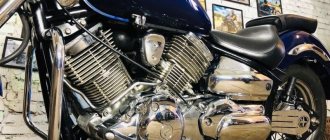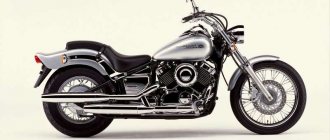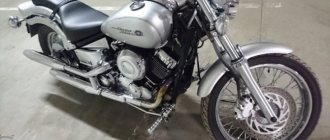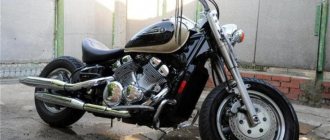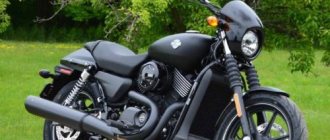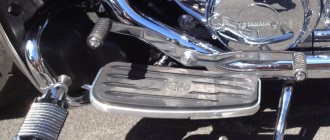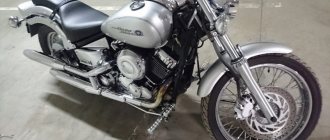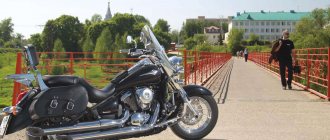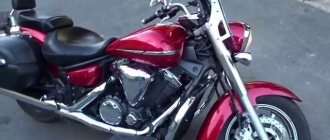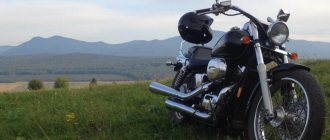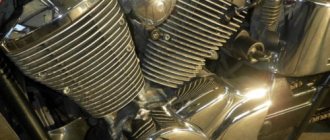The Japanese brand Yamaxa made its first attempt to conquer the American motorcycle markets back in 1981. The Virago model was very popular, but in the mid-90s its star began to decline. Trying to improve the situation, Japanese engineers are releasing a new bike to the American markets. The cruiser concession remained unchanged, but apart from it, the model had nothing remarkable, and the 650 cm3 was, in principle, unable to compete with Harleys. This is how the first version appeared, called Drag Star.
In 1999, taking into account all the errors and shortcomings, the Japanese released a new version - Yamaha XVS1100 Drag Star.
Power point
The classic air-cooled engine with two valves per cylinder is a simple design without any frills or frills.
Starting with the first Virago, versions for Americans are equipped with a 2-cylinder 4-stroke V-engine
- camber angle - 750;
- working volume - 1061 cm3 ;
- power - 62 hp ;
- maximum torque - 85.0 Nm ;
- number of valves - 4 (2 per cylinder) ;
- cooling - air ;
- fuel supply - carburetor ;
- ignition - electronic ;
- start - electric starter, kick starter leg present.
Users noted that when used correctly, the engine does not cause any problems, developing good traction at any speed.
Transmission and clutch
A 5-speed gearbox was installed on the motorcycle.
The principle is standard, the gears are switched on one after another, without the possibility of skipping (sequential scheme). It does not cause any problems, although some users note a rather free and long travel of the clutch pedal, which takes some getting used to. The drive is cardan.
Torque from the engine to the rear wheel is transmitted using a driveshaft.
The clutch is standard for Yamaxa models - 2 discs, oil bath.
Brakes
The motorcycle has disc brakes. A 2-disc version is used at the front, a single-disc at the rear.
Front brakes with two discs.
Single disc rear brakes.
- Disc diameters are 298 mm for the front, 282 mm for the rear.
- The support in both cases is 2-piston . With the development of the model, the front brakes changed, but only slightly. The aluminum alloy was replaced with steel.
In the latest versions, the disc diameter has become 300 mm. These same brakes were inherited by the more powerful (1300) model.
Conclusion about Yamaha Drag Star 1100
The Yamaha Drag Star 1100 motorcycle is ideally adapted to urban conditions. It maneuvers perfectly between cars and never gets stuck in traffic jams. You can make it even more maneuverable by installing a narrow steering wheel. The engine never overheats, even on the hottest summer days. When going on a long trip, you can attach three panniers to the motorcycle - one on the rear trunk and two on the sides. Three chests will be enough to fit everything you need. The only discomfort is in the standard standard seats. They are not too soft. You can, of course, purchase a tuning version, but then you will have to damage the family budget, because the cost of high-quality soft seats is quite high. Despite this, the positive characteristics outweigh, so the demand for this model will never dry up.
Driving characteristics, fuel consumption
The cruising speed is 130 km/h, and it is at this speed that the bike behaves ideally.
Different publications provide different data on consumption and acceleration qualities.
- Maximum speed 180–185 km/h .
- Acceleration to 100 km in 4.8 - 5 seconds .
- In the suburban cycle the consumption is 5 liters , in the city - 6.5 liters .
Modifications
1998 Yamaha XVS 1100 Drag Star Classic.
In 1999, the model was presented to consumers in a configuration that later became the second in the line. It was distinguished by shortened fenders, a certain drag style, especially noticeable in the spoked wheels, and the width of the front tire (110 mm).
For the 1100, 4 different modifications were released. The main differences were in the external body kit and some additional features. The packages were named:
- Classic. In 2000, mass production started with the classic version. It received long fenders and a wide front tire - 130 mm. After 5 years, in 2005, the model received cast wheels.
- Custom. The official start of sales of this modification was in 2001. A model previously presented at car shows was launched onto the production line. No modifications were made.
Yamaha XVS1100 Drag Star Custom – version with short fenders in drag style.
- Silverado. 2003 marks the launch of the Silverado version. It was the Classic already familiar to consumers, but the package added three panniers (rear and side), a windshield, and a backrest for a second passenger.
2006 Yamaha 1100 Drag Star Silverado.
- Midnight Custom. The version was launched in 2005. It was delivered only to the American continent, and was distinguished by its noble black color and a minimum of prominent parts.
Yamaha V-Star 1100 Midnight Custom - minimal chrome and black paint.
Dimensions and weight
The modifications received slightly different external data, so Custom will be listed separately. But you can also notice that the Silverado has a larger width (saddlebags) and height - the windshield.
Custom
- Length - 2405 mm ;
- Width - 895 mm ;
- Height - 1095 mm ;
- Wheelbase - 1640 mm ;
- Seat height - 690 mm ;
- The weight of the motorcycle is 275 kg .
Classic and other modifications
- Length - 2460 mm ;
- Width - 945 mm ;
- Height - 1095 mm ;
- Wheelbase - 1645 mm ;
- Seat height - 710 mm ;
- The weight of the motorcycle is 285 kg .
Appearance of the Yamaha Drag Star 1100 model
The Yamaha Drag Star 1100 model has quite unique technical characteristics. Since this motorcycle is created in the American style, it is all hung with chrome elements. The forks are pushed forward, but not too far forward, like the original American models. The fuel tank is designed in the shape of a drop, and the instrument panel is located on it. The steering wheel is raised high, which creates additional comfort and convenience when driving. Huge chrome mufflers sparkle in the sun. It is impossible to look at them without sunglasses because you have to squint. The unusual exterior is completed by deep, voluminous fenders and two seats with a traditional low seating position for the driver.
The motorcycle is produced in the following versions:
- Classic - there is nothing special about it. Regular budget model. What distinguishes it from the other two versions is its external hardware.
- Custom - This model is equipped with a passenger backrest and a windshield.
- Silverado - This also has a passenger backrest and windshield, but unlike its siblings, this model comes with side saddlebags.
Flaws
According to users, the model has no shortcomings. My wish is to reduce the stroke length of the gearbox pedal. Otherwise, there are no complaints about the box. “..not always clear, but reliable! No questions".
Overall, the motorcycle is reliable and solid, not the most expensive in its class.
The width of the tires is also considered a disadvantage . If the front ones changed from version to version, the rear one was constant, 170 mm. For roads where there may be nails, twigs, glass and other debris that could pierce the camera, the driver had to carry two spare tires, front and rear.
If in automotive realities this is not so critical, then in a motorcycle it created additional problems.
and dignity
We can say that this bike is average in everything, which is why motorcycle enthusiasts like it.
The undoubted advantages due to which the model is still in demand include:
- high reliability of the power plant;
- excellent level of comfort for a bike;
- soft suspension that absorbs all road irregularities well.
Life is such that after 3 seasons of owning LitroDraga, you have to say goodbye to it. I want to talk about my ownership experience. Probably the post will be useful for beginners and those who increase their cubic capacity. Post without pictures, just thoughts. I purchased a draga in the spring of 2014 from one of the sellers of Japanese motorcycles. The seller was pleased with the work, the motorcycle was in good condition and motorcycle life began. Over 3 seasons, about 15-18 thousand km were driven. (but this is not exact, I don’t remember the mileage with which the bike came). Most trips are no further than 400 km, one trip to Baikal (1500 km) and small trips lasting one day. Yes, not a lot, but time and finances didn’t allow me to skate more. For 3 seasons, the bike was equipped with a windshield, two suitcases on the sides and a backrest for the second number. In this form he left me.
Now the actual pros and cons of the motorcycle.
Pros: 1. Anyone who says that a liter is too much for a beginner, go to hell! I have never regretted taking this volume. At first it was scary to unscrew the handle, so I was in no hurry and acted carefully. Then I got used to the topic and started driving normally, in fact, everything is the same as with any vehicle. A liter is enough for one person, and when there are already two of you on the bike, and the things for the next festival are no less than a tent, sleeping bags, warm clothes, food, and so on, then there’s already enough power to spare. For those who like to say that in this class of motorcycles, power is not the main thing, let me explain: I never race anywhere, but I prefer to have a reserve of horsepower for quick overtaking. You can rattle along at 110 km/h even if you have an itch, but overtaking will turn into extreme sports. 2. In the entire history of operation, only one malfunction was detected on the bike. Actually, after painting, the master did not install the bracket for fastening the wiring braid under the rear fender and it (the braid) gradually rubbed against the rear wheel and the light went out. Yes, I was quite nervous then; I had to get home in the dark. Well, the passing car understood what was happening and trailed behind me the whole way, illuminating the road with its headlights. Respect to this comrade! I came home, found it, and fixed it. Otherwise, no complaints. I thought it would be a good idea to adjust the valves, but the adjustment was the same as at the factory, so I just made an inspection and put the bike back together. 3. Kradan! Oh yes, I’m still a lazy person and when I imagine that I would need to change the chain and sprockets, and also take care of the chain, it becomes bad. The cardan is wonderful, the transmission is replaced according to regulations and everything is great.
I can also add that, of course, the motorcycle has a rather serious appearance, you won’t go unnoticed on it)))
Now about the cons:
1. Landing. My height is 170, weight is 70 kg. I don't feel comfortable driving for a long time. The landing is such that you want to either move your legs a little back or move them forward. I constantly slid towards the tank, my tailbone was numb. On a trip to Baikal, I got used to this after a couple of days, but my bottom doesn’t really like a one-day trip. They say that all this disgrace can be cured by installing a tuned Mustang-type saddle. I wanted to give the stock saddle to a master for reupholstery, but I didn’t have time. By the way, arcs with restegs can also help. 2. Service. I can’t say that the service is too inconvenient, I’m probably just being picky. Now, if everything is ok with the air filter, then there is some problem with the oil filter. To replace it, you have to remove the exhaust pipe O_O and the two covers on this same filter generally mislead me, was it really impossible to make one piece of hardware? Well, the spark plugs, you can’t get them without a special spark plug wrench, and I constantly struggled with the wrench, getting into the threads. I don’t know, maybe my hands are not strong enough, but it is what it is. 3. It was on my motor that the forward flow was installed. Direct flow is a personal matter for everyone. But here you need to understand that if you ride long distances, then you will have to listen to the loud exhaust constantly. After a long day it made me a little nervous, there was a buzzing in my ears.
As a result, I believe that LitroDraga is an almost ideal vehicle for a new motorcyclist. The consumption is not high, it does not require much investment, there is enough power for two. After riding for 3 seasons, I realized that I wanted a big bike with a bunch of panniers and music. And in order not to make an electric train out of a dredge, I decided to buy this very electric train.
Chukchi is not a writer.
